ASUS P8Z77-V Premium Review: A Bentley Among Motherboards
by Ian Cutress on August 13, 2012 10:30 AM EST- Posted in
- Motherboards
- Asus
- Z77
ASUS P8Z77-V Premium BIOS
The ASUS graphical BIOS interface is now steadfast in a reviewers mind. It utilizes a dual system of an ‘EZ’ (that is ee-zee rather than the British ee-zed) mode and an advanced mode to tailor the options to the type of user. When a user enters the BIOS, the EZ mode should be presented.
The EZ mode screen is a single interface which contains key valuable information – the name of the motherboard, the version of the BIOS, the CPU model and speed, the memory size and speed, temperatures, voltages, fan speeds, system modes and a boot priority. This is all key information that any system builder, or problem solver, would love the instant we get into the BIOS, so kudos to ASUS for providing this interface. Within the scope of the graphical BIOS, it would be possible to include innovative ways to display this data.
The EZ mode screen allows users to select one of three performance modes - energy saving, normal, or boost. The boost function performs the OC Tuner or 'Fast' overclock settings, as described in the Overclocking section. In addition we have the boot priority menu, were users can slide the device of their choice as first boot device. The Boot Menu allows users to boot from a specific device for just that boot (useful for reviewers installing new OS from USB stick), and the shortcut/Advanced options will take a user to the Advanced Mode menus.
The Advanced Mode menus are more akin to the typical BIOS interface that prevailed before Sandy Bridge and the P67 chipset. With the ASUS P8Z77-V Premium, the first screen in this mode has some more data related to the system, but the main point of the advanced mode is the overclocking section, AI Tweaker:
As you can see in the images above, we have selected XMP, which causes MultiCore Enhancement to be enabled. This MultiCore Enhancement option lets the processor use the top turbo mode of the processor at all times, giving (at stock) a small performance boost under heavily multithreaded workloads.
AI Tweaker contains all the main tools for normal overclocking - the CPU multiplier is adjustable (1-Core Ratio Limit option), as well as the memory and the voltages. In order to change the load line calibration, navigate to the DIGI+ Power Control Menu:
Memory timings can also be adjusted through the DRAM Timing Control menu:
Users can double check to see how the GPU lanes are configured on their multi-GPU setups by navigating to Advanced -> System Agent Configuration -> NB PCIe Configuration:
The Thunderbolt options for the Premium also have their own menu. I did notice that in the beta release BIOS I had with this board compared to the BIOS we are using for this review (1401) that some of these options are different. However, with the 1401 BIOS, ASUS give various options related to the TB port and explanations with them:
Always of note on an ASUS motherboard is the depth of the fan controls that are available. In the BIOS, we have the in-depth options for the fans in the form of Q-Control, which gives either preset profiles or manual adjustment in terms of percentages of fan power and temperatures - something which other motherboards sometimes refuse to do. All the fan headers are controllable through the BIOS. However, with the graphical BIOS being what it is, I would like to see some sort of graphical representation of the fan speeds (similar to that done in the OS) and gradients.
ASUS also offer a BIOS Flash Utility in the BIOS, for users wishing to download the latest BIOS via USB stick on a different machine. The ASUS P8Z77-V Premium also supports USB BIOS Flashback, where users can update the BIOS without the need for a CPU, a video card or memory.


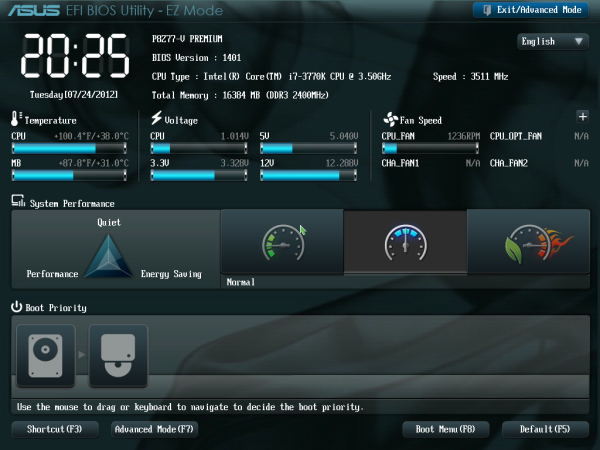
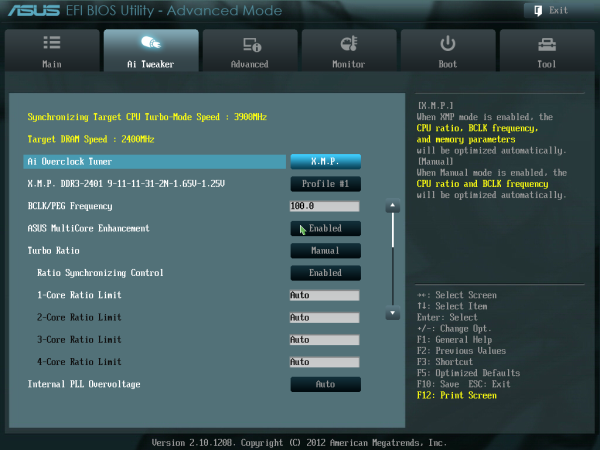

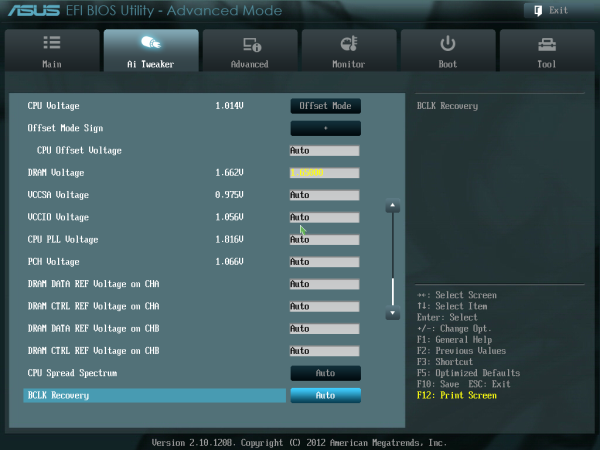
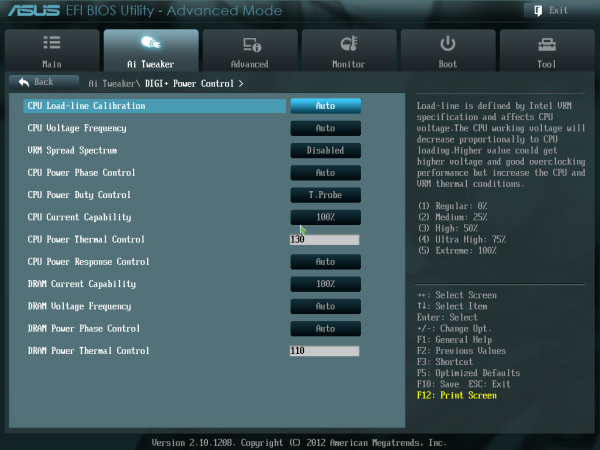
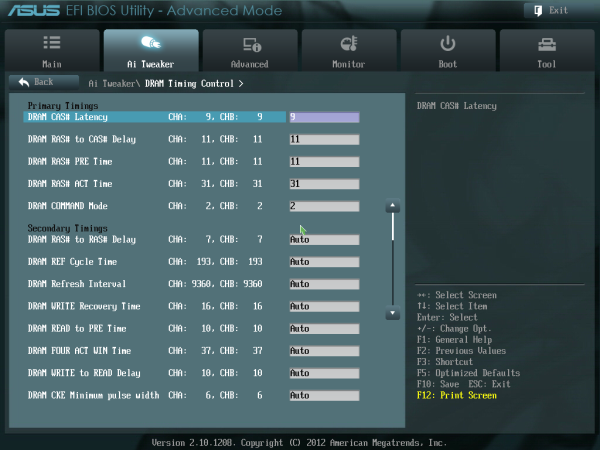

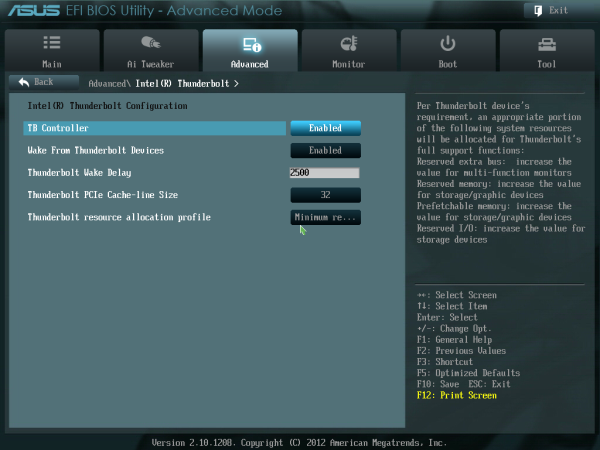














43 Comments
View All Comments
ptrinh1979 - Tuesday, August 14, 2012 - link
I was confused as well, but in my case, I can use this to offload the pagefile without sacrificing a drive bay in my chassis.BytesMage - Tuesday, September 11, 2012 - link
Page file is good for this. Planning on raiding 2 SSDs in raid 0 on Intel then SSD cache ll on the marvel with 2 60gb SSDs to 3tb HDD. I was wondering what to do with the 32gb mSata.ASUSTechMKT - Tuesday, August 14, 2012 - link
The 32GB mSATA was integrated to allow for quick access to utilizing Intel SSD Caching functionality. While many users are adopting high performance SSDs the cost of higher capacities is till high and in addition limited. Mechanical drives still considerably outpace and outsell SSDs in integration in all price points of desktops. Having this 32GB drive integrated easily allows for you to "SSD Cache a 2, 3 or 4TB drive" this allows you to have a much smoother and quicker response experience from the mechanical volume.While not noted the setup has also been streamlined in our utility to allow for a quick one click level of initialization for Intel SSD Caching or ASUS SSD Caching from the Marvell controller.
Rick83 - Monday, August 13, 2012 - link
At this price point, that is fairly ridiculous.So yes, there is "Thunderbolt", but a Firewire 800 Controller would probably be more useful, as there are way more Firewire devices in the wild than Thunderbolt.
Not sure how much the 82579V really can be called "server grade" either.
The 82579V on the Gene-Z shouldn't be all that different, having the same designation, but you have to manually hack the .inf to get the driver to install on Windows server. Not sure what makes this one server grade, seeing as the broken .inf comes directly from Intel.
Checking the other NIC, that one is more likely to be server grade, it costs almost twice as much. Not sure who made that mix-up.
IanCutress - Monday, August 13, 2012 - link
This was my error. The 82583 is not server grade, but as a helpful reader pointed out via email, the 82571, 82572, 82574, 82576, 82580 and I350 are. Super helpful naming scheme to tell them apart... :)Ian
Googer - Monday, August 13, 2012 - link
Thunderbolt is capable if mimicking firewire and just about every other IO technology in existence. So there is no real need for the added PCB Real Estate or monetary expense of a 1394 chip when 1394b is something that never really caught on (SAD).bigboxes - Tuesday, August 14, 2012 - link
Give up on the firewire. It's got USB 3.0. & USB 2.0. Anything you might need beyond that will either be Thunderbolt or some future USB 4.0. I've never needed Firewire. I've wasted money on a Firewire card, but that's not the same thing as needing it, now is it?Rick83 - Tuesday, August 14, 2012 - link
There's a lot of Firewire Video stuff (I'm following the IEEE1394-Linux mailing list, and there is still development and occasional use in a variety of contexts) Also I have a FireWire CF-reader. Not to mention that it's still much cheaper than TB, and in the shape of FW-800 still bloody fast, thanks to physical DMA.Also, at 450 euro, there's just no reason not to mark that check-box. Thunderbird is NOT a drop-in replacement. It's not like there's no space left on the back plane.
I actually had a look at the P8C WS yesterday evening, and it seems that that board is what this board should be, at half the price.
Two server grade NICs, FireWire, DVI out, support for ECC MEM and Xeons.
No WiFi, Thunderbolt, SSD or PLX though, but then those are probably less useful to (me and) most people, than the aforementioned.
Oh and it has 4x SATA less. But then 10x SATA is what my much cheaper GigaByte P55-UD5 has, and had years ago (Yes, they're all in use - Yes I'm looking at the WS because I've been having issues (kernel panics, NICs misbehaving) with it lately and server NICs and ECC probably are a good idea after all)
BoloMKXXVIII - Monday, August 13, 2012 - link
I have to agree with others who are a bit confused why a 32 GB SSD was included. As for the rest of the board, I will keep an eye out for when this board starts dropping in price. It is bound to happen. As long as it doesn't take too long it could fit well into my near future plans.Kristian Vättö - Monday, August 13, 2012 - link
Any idea how the Marvell 9230 SATA 6Gbps controller performs? Marvell's previous controllers haven't been too great, so I'm curious to know if the 9230 is any better.